AUDI A6 2013 Owners Manual
Manufacturer: AUDI, Model Year: 2013, Model line: A6, Model: AUDI A6 2013Pages: 306, PDF Size: 76.92 MB
Page 141 of 306
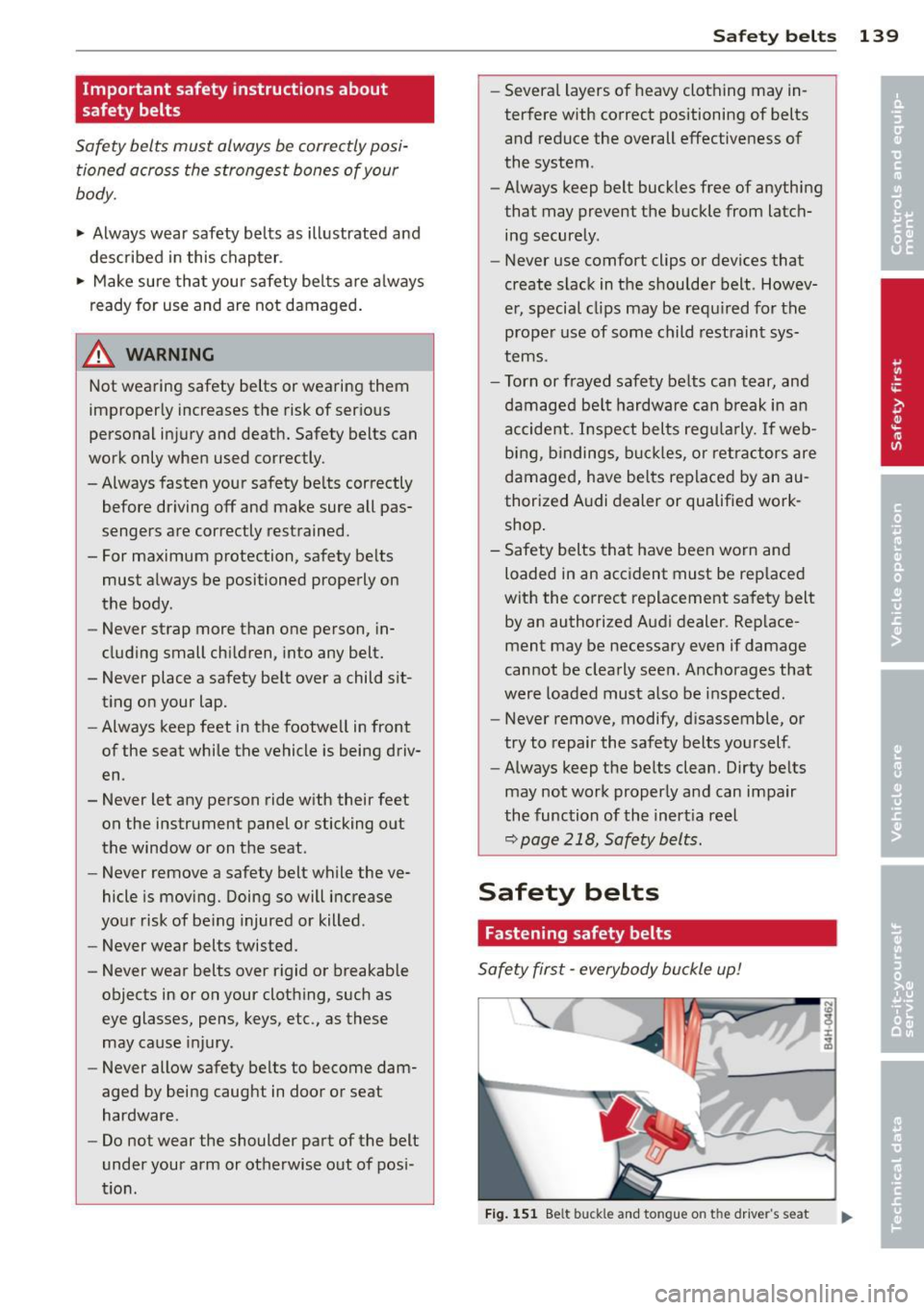
Important safety instructions about
safety belts
Safety belts must always be correctly posi
tioned across the strongest bones of your
body.
~ Always wear safety belts as illustrated and
described in this chapter.
~ Make sure that your safety belts are always
ready for use and are not damaged.
A WARNING
Not wearing safety belts or wearing them
improperly increases the risk of serious
personal injury and death. Safety belts can
work only when used correctly.
- Always fasten your safety be lts correctly
before driving off and make sure all pas
sengers are correctly restrained.
- For maximum protection, safety belts must always be positioned properly on
the body .
- Never strap more than one person, in
cluding small children, into any belt.
- Never place a safety belt over a child sit ting on your lap.
- Always keep feet in the footwell in front
of the seat while the vehicle is being d riv
en .
- Never let any person ride with their feet
on the instrument panel or sticking out
the window or on the seat.
- Never remove a safety belt while the ve
hicle is moving. Doing so will increase
your risk of be ing injured or killed.
- Never wear belts twisted.
- Never wear belts over rigid or breakable
objects in or on your clothing, such as
eye glasses, pens, keys, etc., as these may cause injury.
- Never allow safety belts to become dam
aged by being caught in door or seat
hardware .
- Do not wear the shoulder part of the belt
under your arm or otherwise out of posi
tion . Safety belts
139
- Several layers of heavy clothing may in
terfere with correct positioning of belts and reduce the overall effectiveness of
the system .
- Always keep belt buckles free of anything
that may prevent the buckle from latch
ing securely .
- Never use comfort clips or devices that
create slack in the shoulder belt . Howev
er, special clips may be requ ired for the
proper use of some child restraint sys
tems .
- Torn or frayed safety belts can tear, and
damaged belt hardware can break in an
accident. Inspect belts regularly.
If web
bing , bindings, buckles, or retractors are
damaged, have belts replaced by an au
thorized Audi dealer or qualified work
shop.
- Safety belts that have been worn and
loaded in an accident must be replaced
with the correct replacement safety belt
by an authorized Audi dealer. Replace
ment may be necessary even if damage
cannot be clearly seen . Anchorages that
were loaded must also be inspected.
- Never remove, modify, disassemble, or
try to repair the safety belts yourself.
- Always keep the belts clean. Dirty belts
may not work properly and can impair
the function of the inertia reel
r::;, page 218, Safety belts .
Safety belts
Fastening safety belts
Safety first -everybody buckle up!
Fig. 151 Bel t b uckle and to ngue on the drive r's seat
Page 142 of 306
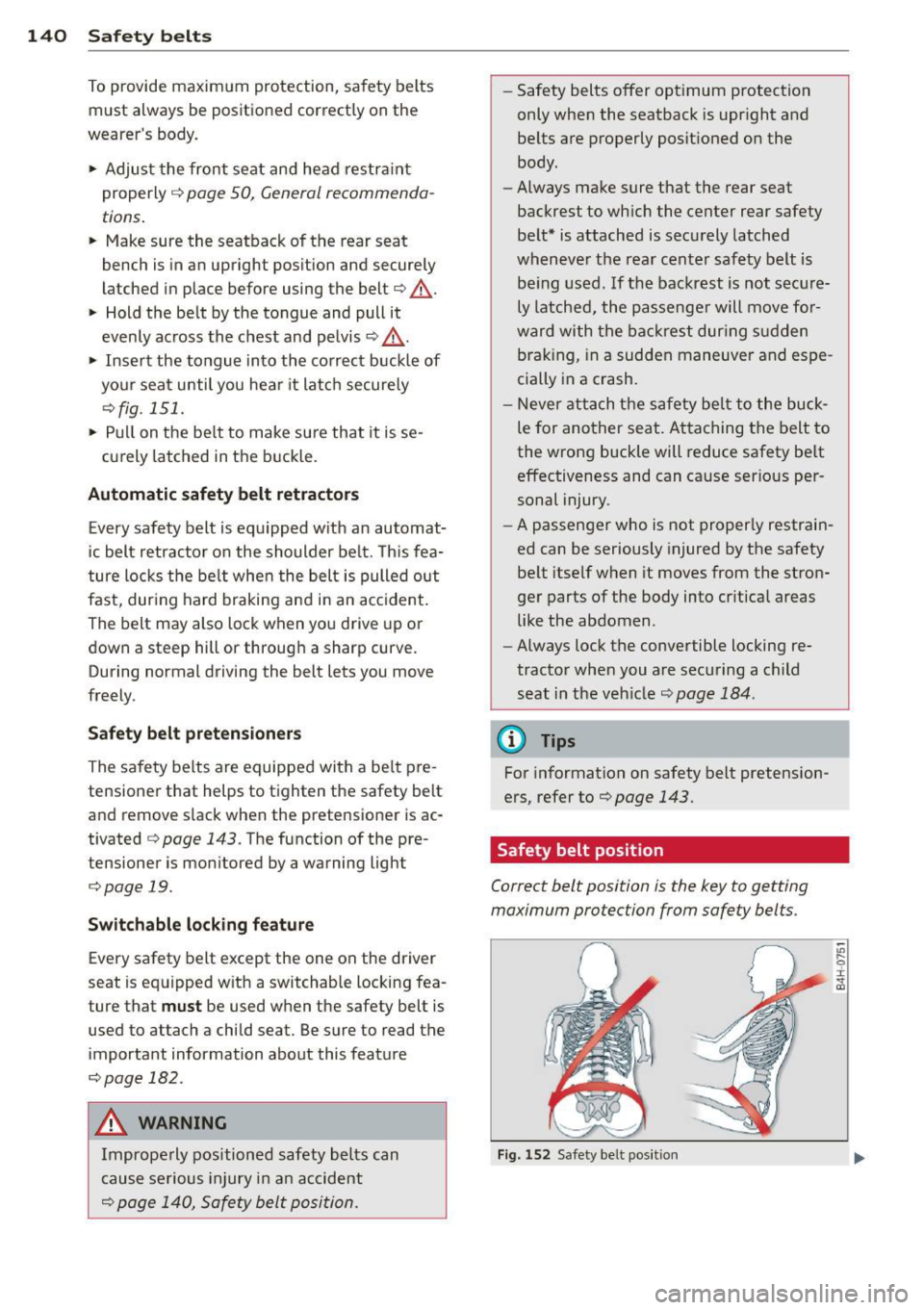
140 Safety belts
To provide maximum protection, safety belts must always be positioned correctly on the
wearer 's body .
.,. Adjust the front seat and head restraint
properly ¢
page 50, General recommenda
t ions .
.,. Make sure the seatback of the rear seat
bench is in an upright position and securely
latched in place before using the belt¢,&.
.,. Hold the belt by the tongue and pull it
evenly across the chest and pelvis ¢ ,& .
.,. Insert the tongue into the correct buckle of
your seat until you hear it latch securely
¢fig. 151.
.,. Pull on the belt to make sure that it is se-
curely latched in the buckle.
Automatic safety belt retractors
Every safety belt is equipped with an automat
ic belt retractor on the shoulder belt. This fea
ture locks the belt when the belt is pulled out
fast, during hard braking and in an accident.
The belt may also lock when you drive up or
down a steep hill or through a sharp curve. During normal driv ing the belt lets you move
freely.
Safety belt pretensioners
The safety belts are equipped with a belt pre
tensioner that helps to tighten the safety belt
and remove slack when the pretensioner is ac
tivated ¢
page 143. The function of the pre
tensioner is moni tored by a warning light
¢ page 19.
Switchable locking feature
Every safety belt except the one on the driver
seat is equipped with a switchable locking fea
ture that
must be used when the safety belt is
used to attach a child seat. Be sure to read the important information about this feature
¢ page 182 .
.,& WARNING
Improperly positioned safety belts can
cause serious injury in an accident
¢ page 140, Safety belt position.
-Safety belts offer optimum protection
only when the seatback is upright and
belts are properly positioned on the
body .
- Always make sure that the rear seat
backrest to which the center rear safety
belt* is attached is securely latched
whenever the rear center safety belt is
being used.
If the backrest is not secure
ly latched, the passenger will move for
ward with the backrest during sudden
braking, in a sudden maneuver and espe
cially in a crash.
- Never attach the safety belt to the buck
le for another seat. Attaching the belt to
the wrong buckle will reduce safety belt
effectiveness and can cause serious per
sonal injury .
- A passenger who is not properly restrain
ed can be seriously injured by the safety
belt itself when it moves from the stron
ger parts of the body into critical areas like the abdomen .
- Always lock the convertible locking re
tractor when you are securing a child seat in the vehicle¢
page 184 .
(D Tips
For information on safety belt pretension
ers, refer to ¢
page 143.
Safety belt position
Correct belt position is the key to getting
maximum protection from safety belts.
Fig. 152 Safety bel t position
"' .... 0
~ CD
Page 143 of 306
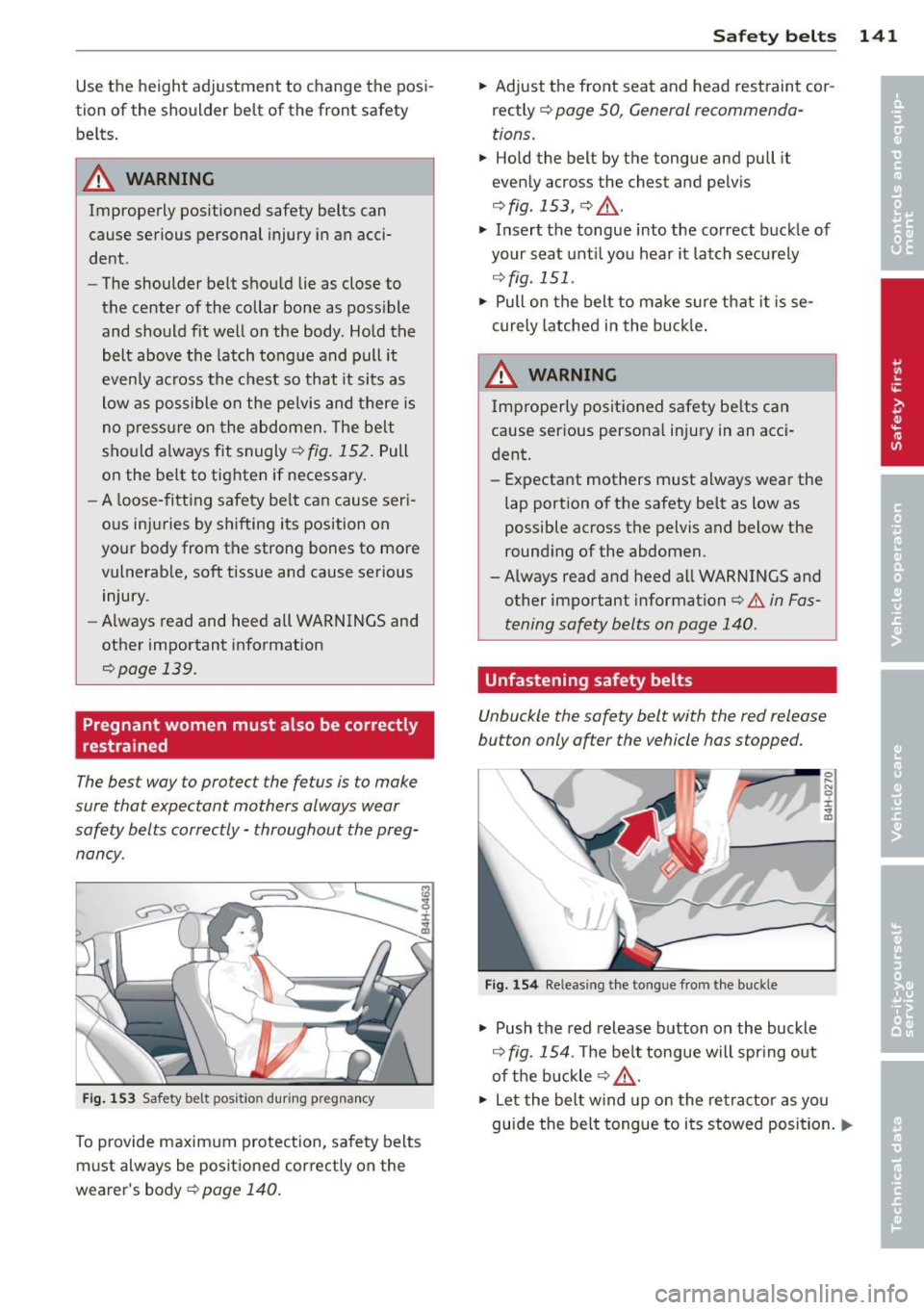
Use the height adjustment to change the posi
tion of the shoulder belt of the front safety
belts .
.&_ WARNING
Improperly positioned safety belts can
cause serious personal injury in an acci
dent.
-
- The shoulder belt should lie as close to
the center of the collar bone as possible
and should fit well on the body. Hold the
belt above the latch tongue and pull it
even ly ac ross the chest so that it sits as
low as possible on the pelvis and there is
no pressure on the abdomen. The be lt
sho uld a lways f it snugly ¢
fig. 152. Pull
on the belt to tighten if necessary.
- A loose-fitt ing safety be lt can cause seri
o us injuries by shifting its position on
yo ur body from the strong bones to more
vulnerab le, soft tissue and cause serious
injury.
- Always read and heed all WARNINGS and
other important information
¢ page 139.
Pregnant women must also be correctly
restrained
The best way to protect the fetus is to make
sure that expectant mothers always wear
safety belts correctly -throughout the preg
nancy.
Fi g. 153 Safety belt pos itio n during pr egnancy
To provide maxim um protection, safety belts
must always be posit ioned correctly on the
wearer's body¢
page 140 .
Safety belts 141
.. Adjust the front seat and head restraint cor
rectly ¢
page 50, General recommenda
tions .
.. Hold the belt by the tongue and pull it
evenly across the chest and pelv is
¢ fig. 153, ¢ if:!. .
.. Insert the tongue into the correct buckle of
your seat until you hear it latch securely
r=:;, fig. 151 .
.. Pull on the belt to make sure that i t is se
curely latched in the buck le .
A WARNING
-
Improperly positioned safety be lts can
cause ser ious persona l injury in an acci
dent.
- Expectant mothers m ust always wear the
lap portion of the safety belt as low as
possible across the pelvis and below the
round ing of the abdomen.
-Always read and heed all WARNINGS and
other important information
i=:;, &. in Fas
tening safety belts on page 140.
Unfastening safety belts
Unbuckle the safety belt with the red release
button only ofter the vehicle has stopped.
,,,,,
Fig . 154 Re leas ing the tong ue from the buck le
.,. Push the red release button on the buckle
r=:;, fig. 154 . The be lt tongue will spr ing out
of the buckle
¢ if:!. .
0 ...
"' 0 ±
~
.,. Let the belt w ind up on the retractor as you
guide the be lt tongue to its stowed position.
Ill>
Page 144 of 306
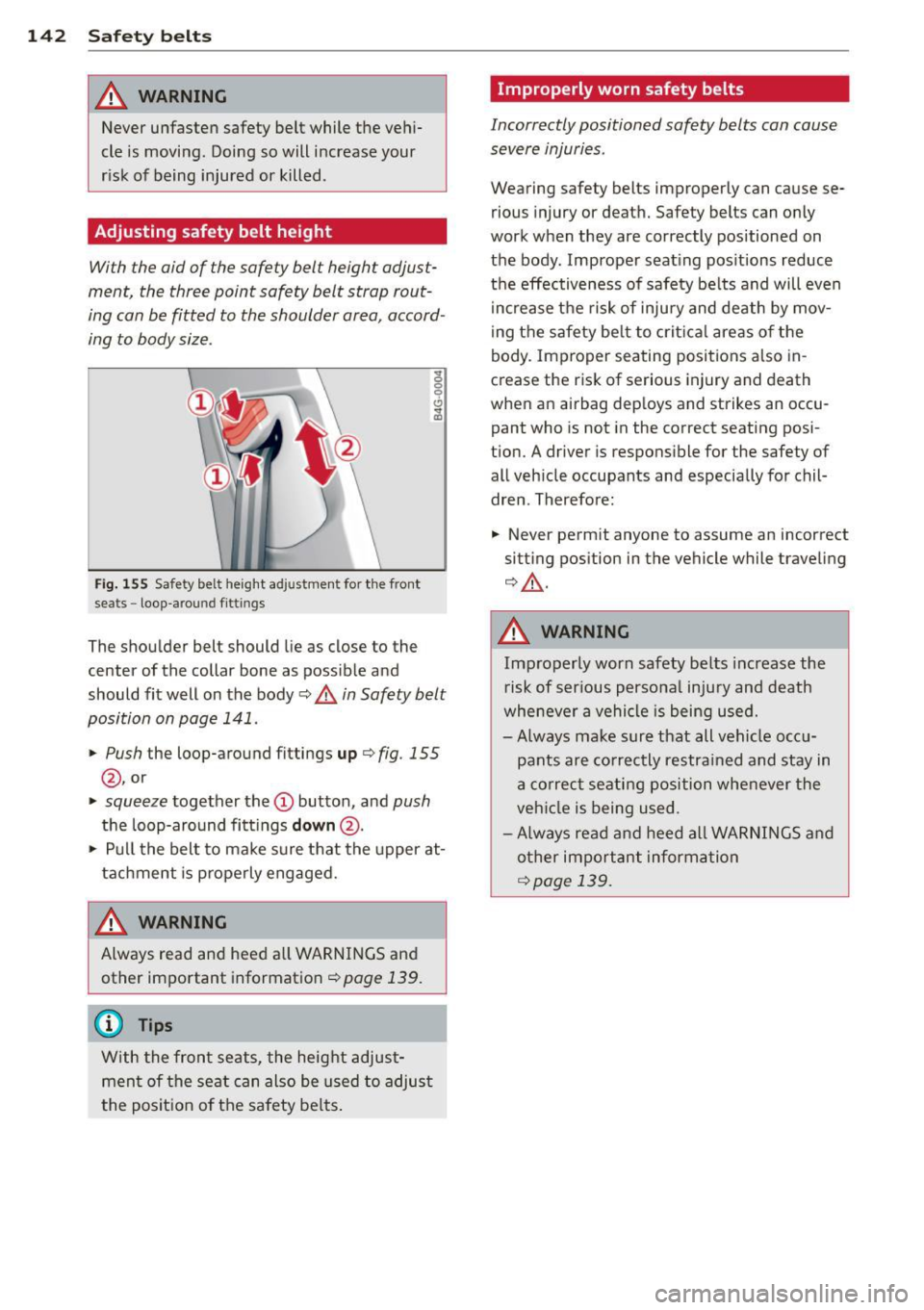
142 Safet y belt s
A WARNING
Never unfasten safety belt while the vehi
cle is moving. Doing so will increase your
r isk of being injured or killed .
Adjusting safety belt height
With the aid of the safety belt height adjust
ment, the three point safety belt strap rout
ing can be fitted to the shoulder area, accord
ing to body size .
Fig. 155 Safety belt height adjustment for the front
sea ts - loop -around f ittings
The shoulder belt should lie as close to the
center of the collar bone as possible and
should fit well on the body
Q A in Safety belt
position on page 141.
,. Push
the loop-around fittings up Qfi g. 155
@, or
"" squeeze together the (D button , and push
the loop-around fitt ings down @.
"" Pul l the belt to ma ke sure that the upper at
tachment is p roperly engaged.
A WARNING
Always read and heed a ll WARNINGS and
other important information
Q page 139 .
@ Tips
With the front seats, the height adjust
men t of the seat can also be used to adjus t
the posit ion of the safety be lts.
Improperly worn safety belts
Incorrectly positioned safety belts can cause
severe injuries .
Wearing safety belts improperly can cause se
rious injury or death. Safety belts can o nly
work when they are correctly positioned on
the body . Improper seating pos itions reduce
the effectiveness of safety belts and will even
i ncrease t he risk of injury and death by mov
ing the safety be lt to crit ica l areas o f the
body. Improper seating positions also in
crease the risk of serious injury and death
when an airbag deploys and strikes an occu
pant who is not in the correct seating posi
tion. A driver is respons ible for the safety of
all veh icle occupants and especially for chil
dren . Therefore:
"" Never permit anyone to assume an incorrect
sitting position in the vehicle while traveling
QA .
A WARNING
Improperly worn safety belts increase the
r isk of ser ious persona l injury and death
whenever a vehicle is being used.
- Always ma ke sure that all vehicle occ u
pants are co rrectly restra ined and stay in
a correc t seating position whe never the
veh icle is being used .
- Always read and heed all WAR NINGS and
o ther important inform ation
Qpage 139.
Page 145 of 306
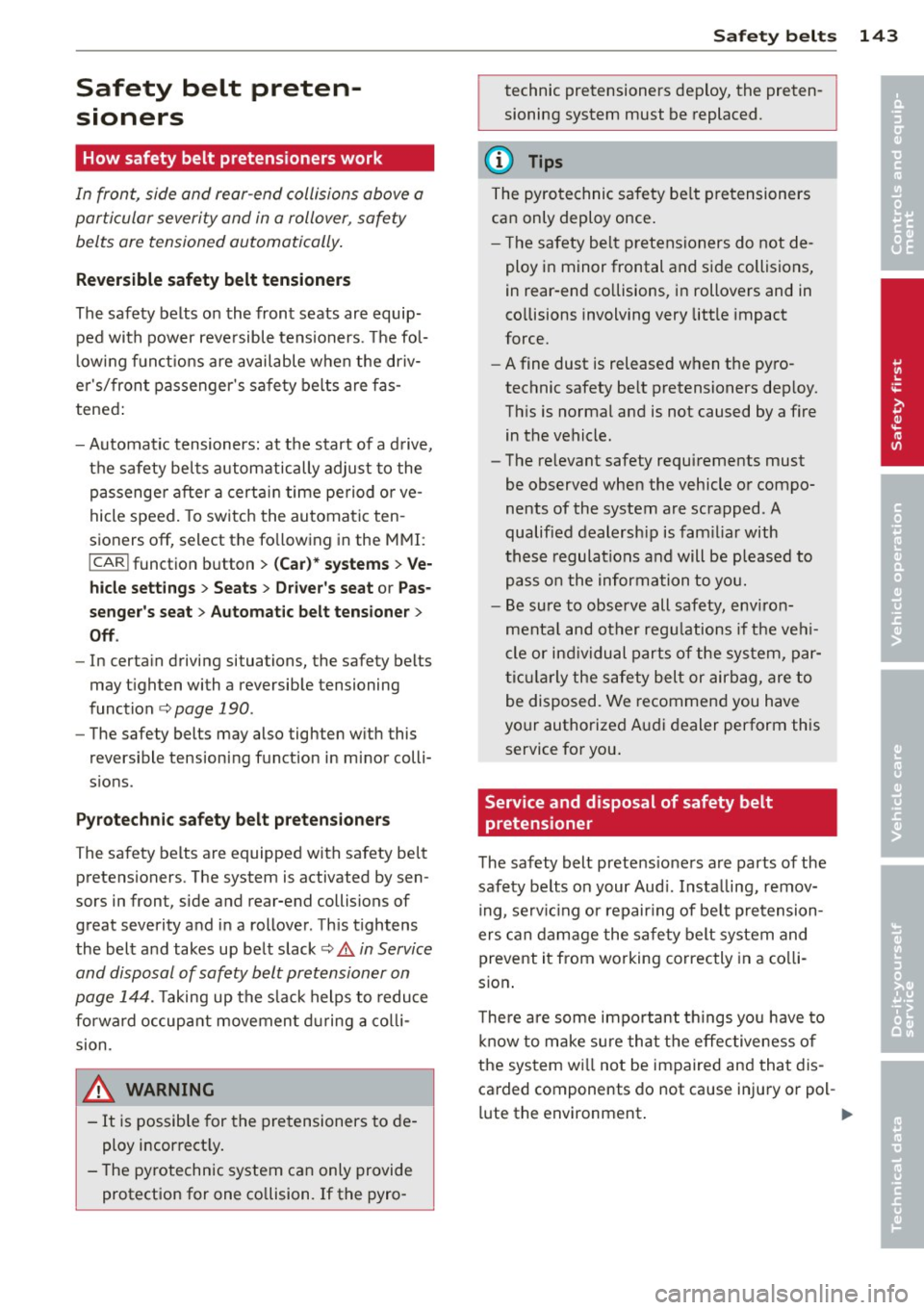
Safety belt preten
sioners
How safety belt pretensioners work
In fron t, side and rear-end collisions above a
parti cular severi ty and in a rollover, safety
b e lts ar e te nsion ed automatically .
Reversible safety belt tensioners
The safety belts on the front seats are equip
ped wit h power reve rsible tensioners . T he fo l
l ow ing f un ct ions are available w hen the dr iv
e r' s/fron t passenger 's sa fety bel ts are fas
tened :
- Automatic tensioners: at the start of a d rive,
the safety be lts automatically adjust to the
passenge r aft er a certai n time period o r ve
hicle speed. To switch the automa tic ten
s ioners off, select the fo llow ing in the M MI:
I CAR I funct ion button > (Car )* systems > Ve·
hide sett ings
> Seats > Driver 's seat or Pas
senger's seat
> Automat ic belt tensione r >
Off.
-In certa in driving situations, the safety belts
may t ighten with a reversib le tensioning
function
¢ page 190.
-The safety belts may also tighten w ith this
r evers ible tension ing funct ion in mino r colli
s ions .
Pyrotechnic safety belt pretensioners
The safety be lts are equipped with safety be lt
pretensioners. The system is activated by sen
s o rs in fron t, side and rear-end collisions of
great severity and in a rollover . Th is tightens
the bel t and takes up be lt slack ¢&.
in Service
and disposal of safety belt pre tensioner on
page 144.
T aking up the s lack helps to redu ce
forward occup ant movemen t during a colli
sion.
A WARNING
- It is possib le for the pre tensioners to de
ploy i ncor rect ly .
- T he pyrotechnic sys tem can only provide
protection for one co llision. If the pyro -
Safety belts 143
technic pretensioners deploy, the preten
sioning system must be replaced .
(D Tips
The pyro technic safety be lt pretensioners
ca n only deploy once .
- T he safety bel t pretensioners do not de
ploy in minor frontal and s ide collisions,
in rear-end co llisions, i n rollovers and in
co llisions involving very little impact
f o rce.
- A fine dust is released w hen the py ro
technic safety be lt pretensioners dep loy.
Th is is normal and is not caused by a fire
in the vehicle.
- The re levant safety requi rements must
be observed when the vehicle or compo
nents of the system are scrapped . A
qualified dealership is fam iliar with
these regulations and will be please d to
pa ss o n the information to yo u.
- Be sure to observe all safety, env iron
ment al and ot her regu la tio ns if t he ve hi
cle or ind ividu al p ar ts of t he system, par
t ic ular ly the s afe ty belt or airbag, are to
be disposed. We recommend you have
your authorized A udi dealer perform this
service fo r you .
Service and disposal of safety belt
pretensioner
The safety belt pretens ione rs are parts of the
saf ety be lts on your Aud i. Insta lling, remov
i ng, se rv ici ng o r repair ing of be lt pre tension
ers can dam age the safe ty belt sy stem and
prevent it from working correctly in a co lli
sio n.
T he re a re some impo rtan t thi ngs you have to
kn ow to m ake su re th at the effectiveness o f
t h e sys tem w ill not be impaired and tha t dis
ca rded components do not cause injury o r pol -
lu te the environment . ..,_ •
•
Page 146 of 306
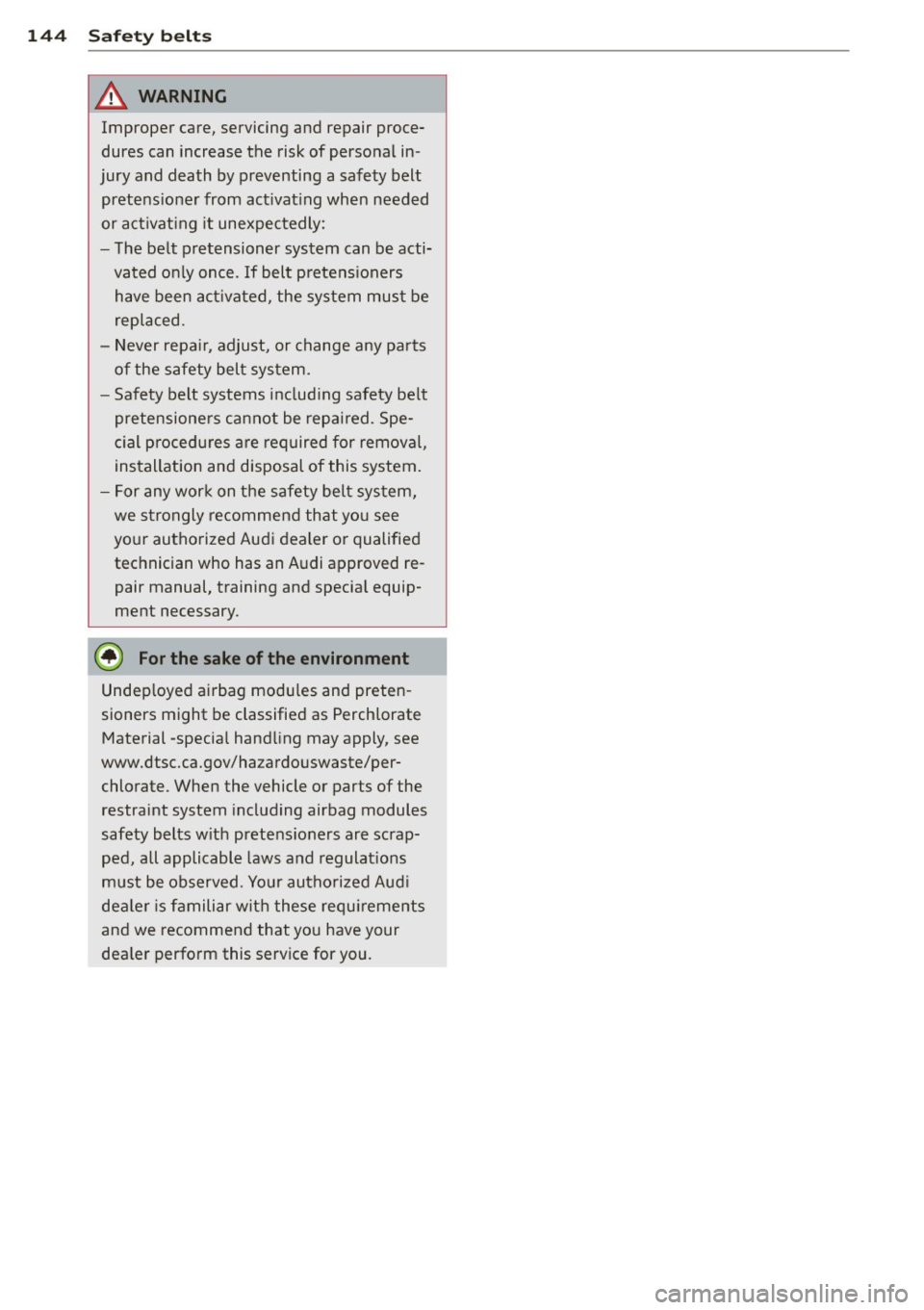
144 Safety belts
,8. WARNING
Improper care, servicing and repair proce
dures can increase the risk of personal in
jury and death by preventing a safety belt
pretens ioner from act ivat ing when needed
or act ivat ing it unexpectedly:
- The belt pretensioner system can be acti
vated only once. If belt pretens ioners
have been act ivated, the system must be
replaced.
- Never repair, adjust, or change any parts
of the safety belt system.
- Safety belt systems includ ing safety be lt
pretensione rs cannot be repaired. Spe
ci al procedures are required for removal,
installation and disposal of this system.
- For any work on the safety belt system,
we strongly recommend that you see
your authorized Audi dealer or qualified
technician who has an Audi approved re
pair manual, training and specia l equip
ment necessary.
@ For the sake of the environment
Undep loyed airbag modu les and preten
sioners might be classified as Perchlorate
Material -specia l hand ling may apply, see
www.dtsc.ca.gov/haza rdou swaste/per
chlorate. When the vehicle or parts of the
restraint system including airbag modules
safety belts w ith pretens ioners are scrap
ped, all applicable laws and regulations
must be observed. Your authorized Aud i
deale r is familiar with these requ irements
and we recommend that you have your
dea ler perform this service for you.
Page 147 of 306
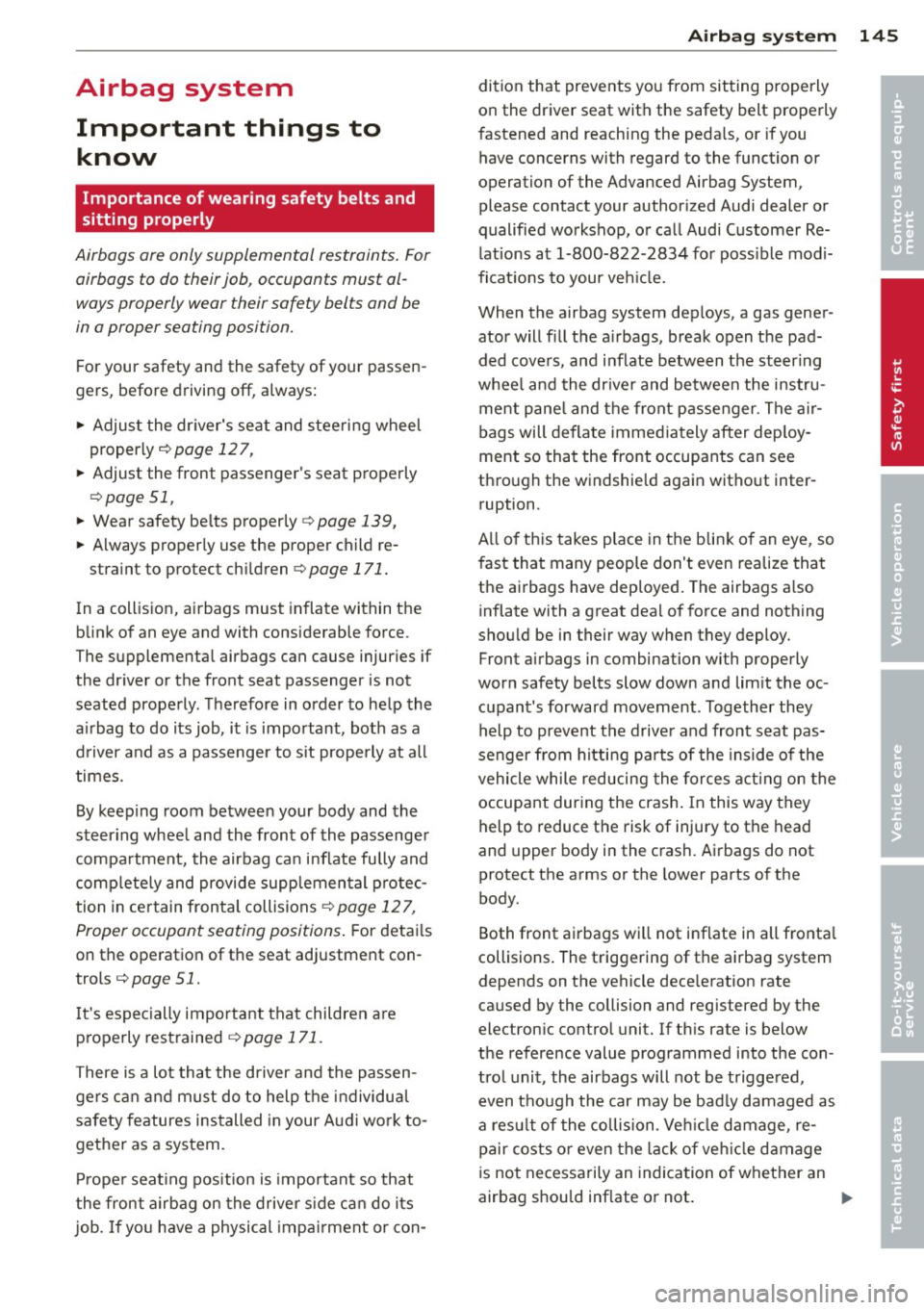
Airbag system Important things to know
Importance of wearing safety belts and
sitting properly
Airbags are only supplemental restraints. For
airbags to do their job , occupants must al
ways properly wear their safety belts and be
in a proper seating position.
For your safety and the safety of your passen
gers, before driving off, always:
"" Adjust the driver's seat and steering wheel
properly ¢
page 12 7,
"" Adjust the front passenger's seat properly
¢page 51,
"" Wear safety be lts properly ¢ page 139,
"" Always properly use the proper child re-
straint to protect chi ldren ¢
page 171.
In a collision, airbags must inflate within the
blink of an eye and with considerable force.
The supplemental airbags can cause injuries if
the driver or the front seat passenger is not
seated properly . Th erefore in order to help the
a ir bag to do its job, it is important, both as a
driver and as a passenger to s it properly at all
times.
By keeping room between your body and the
steering wheel and the front of the passenger
compartment, the airbag can inflate fully and
comp letely and provide supplemental protec
tion in certain frontal collisions ¢
page 12 7,
Proper occupant seating positions. For details
on the operation of the seat adjustment con
trols
¢ page 51.
It's especially important that children a re
properly restrained ¢
page 171.
There is a lot that the driver and the passen
gers can and must do to help the individual
safety features installed in your Aud i work to
gether as a system.
Proper seating pos ition is important so that
the front airbag on the driver side can do its
job. If yo u have a physical impa irment or con-
Airbag system 145
dition that prevents you from sitting properly
on the driver seat with the safety belt properly
fastened and reach ing the peda ls, or if you
have concerns with regard to the function or
operation of the Advanced Airbag System,
please contact your author ized Audi dealer or
qualified workshop, or call Audi Customer Re
l ations at 1-800-822-2834 for poss ible modi
fications to your vehicle.
When the airbag system dep loys, a gas gener
ator will fill the a irbags, break open the pad
ded covers, and inflate between the steer ing
whee l and the driver and between the instru
ment pane l and the front passenger. The air
bags will deflate immediately after deploy
ment so that the front occupants can see
through the windshield again without inter ruption .
All of th is takes place in the blink of an eye, so
fast that many people don't even realize that
the airbags have deployed. The airbags a lso
inflate with a great dea l of force and nothing
should be in their way when they deploy.
Front airbags in combination with properly
worn safety belts slow down and lim it the oc
cupant's forward movement . T ogether they
help to prevent the driver and front seat pas
senger from hitting parts of the inside of the
vehicle while reducing the forces acting on the
occupant during the crash . In this way they
help to reduce the risk of injury to the head
and upper body in the crash. Airbags do not
protect the arms or the lower parts of the
body.
Both front airbags will not inflate in all fronta l
collisions . The triggering of the airbag system
depends on the vehicle dece leration rate
caused by the collision and registered by the
electron ic control unit. If th is rate is below
the reference value programmed into the con
trol unit, the airbags will not be trigge red,
even though the car may be bad ly damaged as
a result of the collision . Ve hicl e damage, re
pair costs or even the lack of veh icle damage
is not necessarily an indication of whether an
airbag should inflate or not . .,. •
•
Page 148 of 306
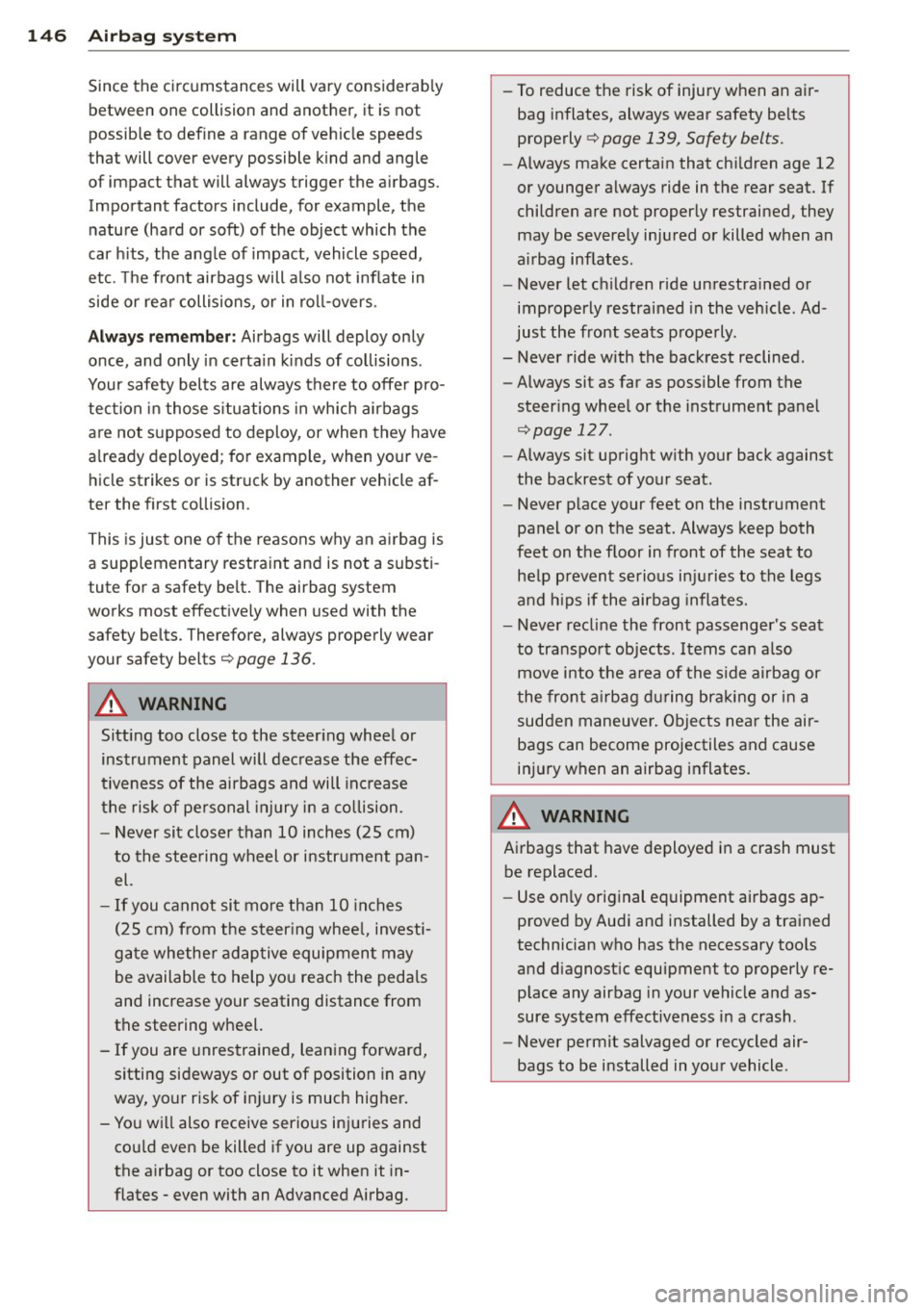
146 Airbag sys te m
Since the cir cumstances will vary considerab ly
between one collision and anot her, it is not
possib le to def ine a range of vehicle speeds
that will cover every possible k ind and angle
of impact t hat will always trigger the airbags.
Important factors include, for example, the
nature (hard or soft) of the object which the
car h its, the ang le of impact, vehicle speed,
etc. The front airbags will also not inflate in
side or rea r collisions, or in ro ll-overs .
Always rememb er: Airbags will deploy only
once, and only in certa in k inds of co llisions.
Your safety belts are always there to offer pro
tection in those s ituations in which airbags
a re not supposed to deploy, or when they have
a lready deployed; for example, when your ve
hicle strikes or is struck by another vehicle af
ter the first co llision.
This is just one of the reasons why an airbag is
a supplementary restraint and is not a substi
tute for a safety belt . The airbag system
works most effect ively when used with the
safety belts. Therefore, always properly wear
your safety belts¢
page 136.
A WARNING
Sitting too close to the steer ing wheel or
instrument panel will dec rease the effec
t iveness of the airbags and will increase
the risk of personal injury in a collision .
- Never sit closer than 10 inches (2S cm)
to the stee ring wheel or instrument pan
el.
- If you cannot sit more than 10 inches
( 2 5 cm) from the s teer ing whee l, investi
gate whethe r adaptive equipmen t may
be available to help you reach the pedals
and increase your seating distance from
the steering wheel.
- If you are unrestrained, lean ing fo rward,
sitting sideways or out of position in any
way, your risk of in jury is much higher.
- You will also receive serio us injuries and
cou ld even be killed if you are up against
the airbag or too close to it when it in
flates - even with an Advanced Airbag. -
To reduce the risk of injury when an a ir
bag inflates, always wear safety be lts
properly ¢
page 139, Safety belts.
-Always make certain that ch ildren age 12
or younger always ride in the rear seat. If
children are not properly restrained, they
may be severely injured or killed when an
airbag inflates.
- Never let children ride unrestrained or
improperly restrained in the vehicle. Ad
just the front seats prope rly .
- Never ride with the back rest reclined.
- Always sit as far as possible from the
steer ing whee l or the instrument pane l
¢page 127.
-Always sit upright with your back against
the backrest of your seat .
- Never p lace your feet on the instrument
panel or on the seat. Always keep both
feet on the floor in front of the seat to
help prevent serio us in ju ries to the legs
and h ips if the airbag inflates.
- Never recline the front passenger 's seat
to transport objects , Items can a lso
move into the a rea of the s ide airbag or
the front a irbag du ring bra king or in a
sudden maneuve r. Objects nea r the air
bags can become projectiles and cause
in jur y when an airbag inflates.
A WARNING ~
Airbags that have deployed in a crash must
be replaced.
- Use on ly orig inal equipment airbags ap
proved by Aud i and installed by a trained
technician who has the necessary too ls
and d iagnost ic equipment to properly re
p lace any airbag in your vehicle and as
sure system effectiveness in a crash .
- Never permit salvaged or recycled air
bags to be installed in your vehicle.
Page 149 of 306

Child restraints on the front seat - some
important things to know
.. Be sure to read the important information
and heed the WARNINGS for important de
tails about chi ldren and Advanced Airbags
~ page 171.
Even though your vehicle is equipped with an
Advanced Airbag System, make certain that
a ll chi ldren, especially those 12 years and
younger, always ride in the back seat properly restrained for their age and size. The airbag
on the passenger side makes the front seat a potentially dangerous place for a child to r ide .
The front seat is not the safest place fo r a
chi ld in a fo rward-facing chi ld seat. It can be a
very dange ro us p lace for an infant or a ch ild in
a rearward -facing seat.
The Advanced Airbag System i n your veh icle
has been cert ified to comp ly with the require
men ts of United States Federa l Mo to r Veh icle
Safety Standard 208 as applicable at the time
your vehicle was manufactured.
The Standard requires the front a irbag on the
passenger side to be t urned off ("sup
p ressed") if a chi ld up to about one year of
age restrained in one of the rear -facing or for
ward -facing infant restraints listed i n Federal
Motor Vehicle Safety Standard 208 with wh ich
the Advanced Airbag System in your vehicle
was certified has been installed o n the front
passenger seat. For a listing of the child re
straints that were used to certify compliance
with the US Safety Standard ~
page 173.
The PASS ENG ER AIR BAG OFF light in the in
strument panel te lls you when the front Ad
vanced A irbag on the passenger side has been
turned off by the e lectronic control u nit.
Each t ime you sw itch on the ignit ion, the
PAS
SENGER AIR BAG OFF
light w ill come on for a
few seconds and:
- will stay on if the front passenger seat is not
occupied,
- will stay on if the electrical capacitance
measured by the capacitive passenger de
tection system for the front passenge r seat
A irbag sys tem 147
equa ls the combined capacitance of an in
fant up to about one year of age and one of the rearwa rd-facing or forward-facing ch ild
restraints listed in Federal Motor Vehicle
Safety Standard 208 with which the Ad
vanced Airbag System in your ve hicle was
cert ified. For a listing of the child restraints
that were used to certify your vehicle's com p lia nce w ith the U.S. Safety Standard
~page 173.
-w ill stay on if t he re is a small ch ild or child
restrai nt on the front passenge r seat,
- w ill go off if the front passenger seat is oc
cupied by an adult as registered by the ca
pacitive passenger det ection sys tem
~ page 15 7, Monitoring the Advanced Air
bag System.
T he PASSENGER AIR BAG OFF lig ht comes on
when e lec trica l capacitan ce registe red on the
front passenger seat is eq ua l to or less than
the combined capacitance of a typical 1 year
o ld infant and one of the rearward-facing or
forward -facing chi ld restraints listed in Feder
al Motor Vehicle Safety Standard 208 with
which the Advanced Airbag System in your ve
hicle was certified.
If the total e lectr ica l capacitance registered
on the front passenger seat is more than that
of a typical 1 year-o ld child but less than the
weight of a small adu lt, the front airbag on
the passenger side can deploy (the
PASSEN
GER AIR BAG OFF
light does not come on).
If the
PASSENGER AIR BAG OFF light does
not come on, the front airbag on the passen
ger side has not been turned off by the e lec
tron ic contro l unit and ca n deploy if the con
t rol unit senses an impact that mee ts the co n
di tions s to red in its memo ry.
For example, th e airbag may deploy if:
-a small ch ild that is heav ier than a typical 1
year-old chi ld is on the front passenger seat
(regard less of whether the child is i n one of
the ch ild seats listed~
page 173), or
- a child who has outgrown child restraints is
on the front passenge r seat. .,,. •
•
Page 150 of 306
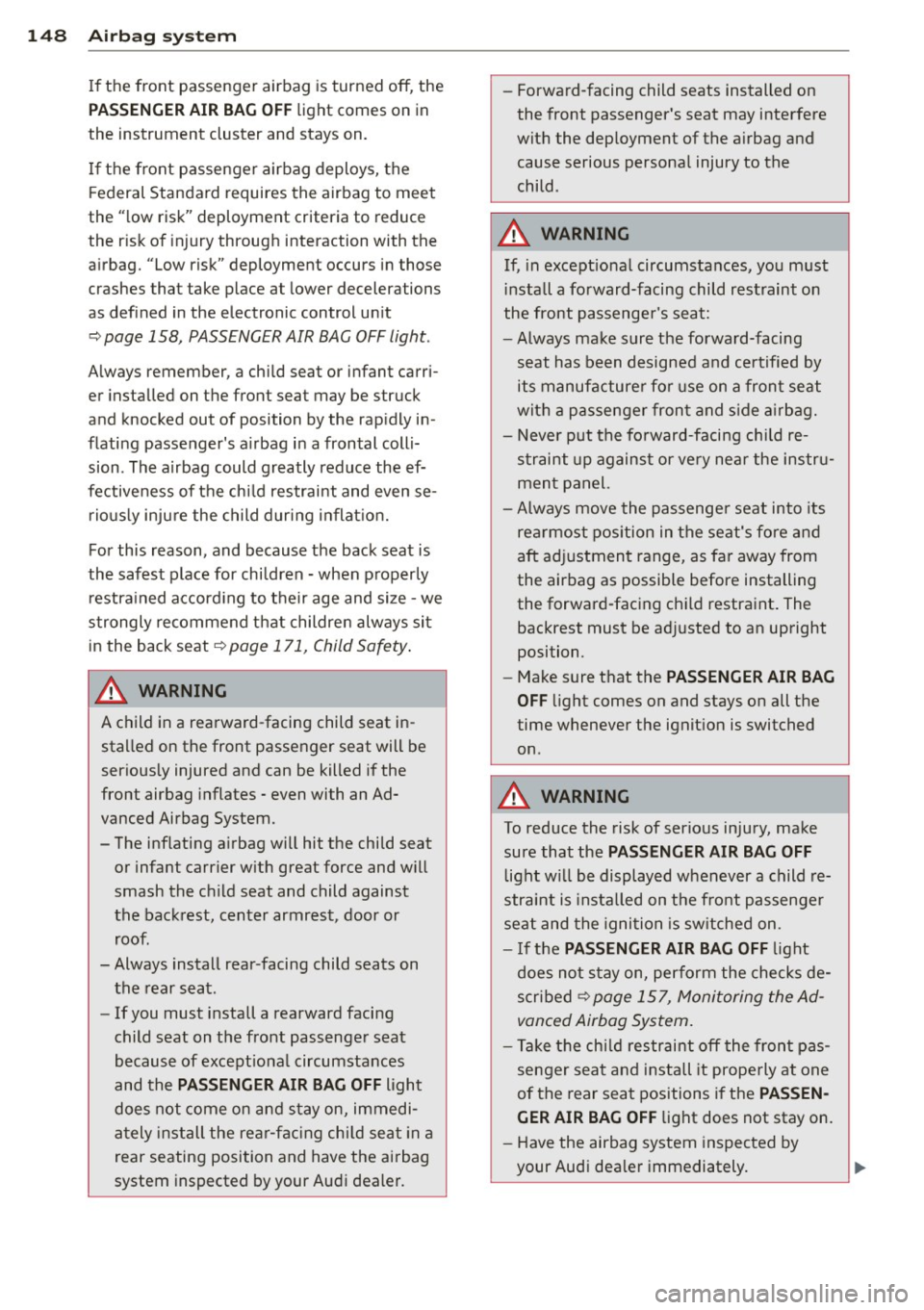
148 Airbag sys tem
If the front passenger airbag is turned off , the
PASSENGER AIR BAG OFF light comes on in
the instrument cluster and stays on .
I f the front passenger airbag deploys, the
F ederal Standard requires the airbag to meet
the " low risk" deployment criteria to reduce
the r isk of in jury through interaction with the
a irbag. "Low ris k" deployment oc curs in tho se
c rashe s that take pl ace a t lower decele ra tions
as defined in the electronic control un it
c::> page 158, PASSENGER AIR BAG OFF light.
A lw ays r emember, a chi ld seat or infant carri
er installed on the front seat may be s truck
and knocked out of position by the rap idly in
flati ng passenger's a irbag i n a frontal colli
sion . The airbag could greatly reduce the ef
fectiveness of t he ch ild restrai nt and even se
r io usly in ju re the child during infla tion.
For this reason, and because the back seat is
the safest place for chi ldren - when p roperly
r estra ined a ccord ing to the ir age and size - we
strongly recommend t hat childre n always si t
in the back seat
c::> page 171, Child Safety .
& WARNING
-
A child in a rearward -facing child seat in
stalled on the front passenger seat will be
ser iously injured and can be killed if the
front airbag inflates - even with an Ad
vanced Airbag System.
- The inflating a irbag will hit the child seat
or infant carrier w ith great force and w ill
smash the ch ild seat and child against
the bac krest , cen ter armres t, door or
roof.
- Always install rear-facing child seats on
the rear seat.
- If you must i nstall a rearward facing
child seat on the front passenge r seat
because of except iona l circumstances
and the
PASSENGER AIR BAG OFF ligh t
does not come on an d stay on, immedi
a tely install the re ar-facin g chi ld seat in a
rear seating position and have the ai rbag
system inspected by your Aud i dealer. -
Forwa rd- facing child seats installed on
the front passenger 's seat may interfere
wit h the dep loyment of the a irbag and
cause serious persona l injury to the
child .
& WARNING
-If, in except ional circumstances, you m ust
i nstall a forward-facing child restraint on
the front passenge r's seat:
- Always make sur e the forward-facing
seat has been designe d and certified by
its m anufacture r for u se on a fron t se at
wit h a passenger fron t and s ide airba g.
- Never p ut t he fo rward -facing child re
s tra int up agains t or ve ry near the instru
men t pa nel.
- Always move the passenge r seat into it s
rearmost pos ition in the seat' s fore and
aft a djustmen t range, as fa r away from
the air bag as possible before installing
the forwar d-facing ch ild restra int . The
backrest must be ad justed to an upright
position.
- Make sure that the
PASSENGER AIR BAG
OFF
li ght comes on and stays on all the
time whenever the ignit ion is switched
on .
& WARNING
-To reduce the risk of serious injury, make
sure that the
PASSENGER AIR BAG OFF
light w ill be display ed whe nev er a child re
straint is insta lled on the front pa ssenger
se at and the ignition is sw itche d on .
- If the
PASSENGER AIR BAG OFF light
does no t stay on, per form the che cks de
scribed
c::> page 15 7, Monitoring the Ad
vanced Airbag System.
- Ta ke t he chi ld restraint off the fron t pas
senger sea t and inst all it prope rly at one
of the rear seat positions i f the
PASSEN
GER AIR BAG OFF
li ght does not stay on.
- Have the airbag system inspected by
your Aud i dea le r i mmediately.